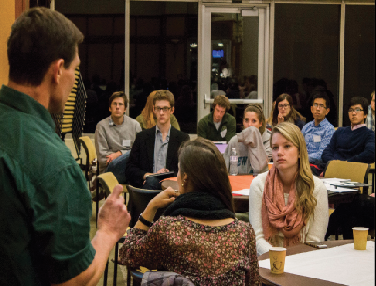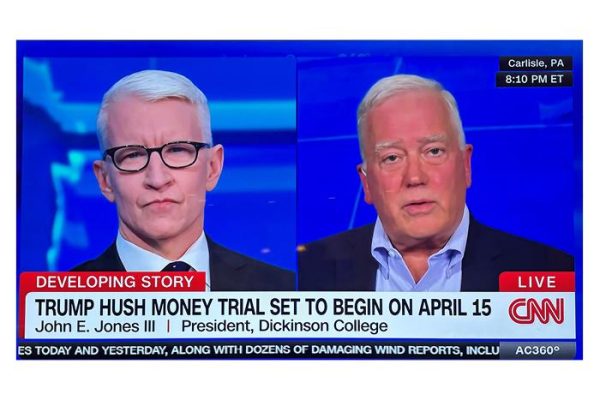Pans for HUB, Housing Discussed in Senate Meeting

Students listening to a presenter talk about the future Senate projects in the Social Hall on Nov. 12
To help educate students on what changes they can expect in the coming year, Student Senate hosted a discussion on possible changes to the HUB, Allison Hall and Housing on Nov. 12, 2013 at 7 p.m. in the HUB Social Hall.
Lead by Student Senators and Student Senate President William Nelligan ’14, the talks opened with changes to the amenities of the HUB. The first subject of the conversation regarded the seating, often nicknamed the cushies, located on the top floor of the HUB, next to the cafeteria windows. Suggestions were made to create a more modern meeting space, with bistro-style table seating and different types of modernized couches and chairs.
Upon being asked how the tables would differ from the seating available in the
Underground, the speakers responded that the tables would reduce cost, and have been recommended by Vice President of Student Development Joyce Bylander.
The blueprint and purpose for what Dickinson plans on doing with the recently acquired Allison Hall were also brought to attention. According to a presentation given by the Space Planning Committee, Allison Hall will include a social hall similar to The Depot, which was taken down by the college in 2012 in order to create more room for the expansion of the Kline Center. The committee would like the new features of Allison Hall to include a main area, a dance floor-like space and a third area that will serve as an interfaith chapel area. Ideas were also being thrown around about the Peddler coffee stand being open later at night, game room in Allison and even the possibility of including it’s own bar.
The Director of Institutional Research Mike Johnson presented the next topic of conversation, Dickinson’s retention rate. According to the presentation, the campus has increased rates of diversity among admitted students while providing, on average, a 38.1% discount rate. In the end game, Johnson said the optimal retention rate would be at 93%, of which we come in 2.2% short at 90.8%.
“The task of raising our retention rate does not fall solely on the admissions office and the college administration,” said Class President Howard Keenan ’16. “Students need to understand that our voice and our opinions are extremely influential to enhancing the Dickinson experience for all community members, leading to higher student satisfaction and a higher retention rate.
When the floor was opened up to discuss ways to raise retention rates, Adam Laird, ’14 suggested the growth of a mentoring system for students on top of encouraging the development of close-knit groups.
Others, such as Nick Toole ’16, stated that freshman year orientation was vital to a first year’s initial experience and that there are many holes in the process.
“The most significant issue addressed tonight was the discussion on retention rates,” said Junior Class Senator Lea Diggs ’15. “College is a difficult transition period and finding the right school is one of the most important factors in personal development and maturation. The fact that Dickinson researches and examines ways to increase the retention rate, once again proves that Dickinson College cares about its students based upon individual needs.”
Dan Confer ’02, the Assistant Director of Campus Life, then took the stage to discuss housing. This segment of the discussion was more of a Question and Answer format.
The first question raised was from Nasir Ellis ’15, who asked about the purpose of building new dorms as opposed to renovating old ones. Confer responded saying that a new dorm building would be years down the road, however smaller renovations are done on a yearly basis.
The last part of the event was a discussion about sustainability, presented by Assistant Director of CSE Lindsey Lyons. The beginning of the presentation started with Lyons bringing forward data to show that 62% of applicants care about sustainability when selecting colleges. Accordingly, about 80% of students recognized the importance of sustainability in their decision to attend Dickinson.
“I feel that sustainability reflects a deeper desire for the administration to invest in the student,” said Joseph Socci ’15. “It definitely played a huge role in my decision to attend this college.”
Lyons then brought up a new, easier way to find transportation using the newly implimented RidePost. RidePost, which will be advertised by class presidents and student senate over the next few weeks, is an online way of posting who you are, where you need a ride to and how much you are willing to pay for that ride. Not only can passengers post on the site, but drivers can as well, with the amount they are requesting from passengers to the destination.
For more information, check out www.dickinson.ridepost.com or contact a member of student senate.



